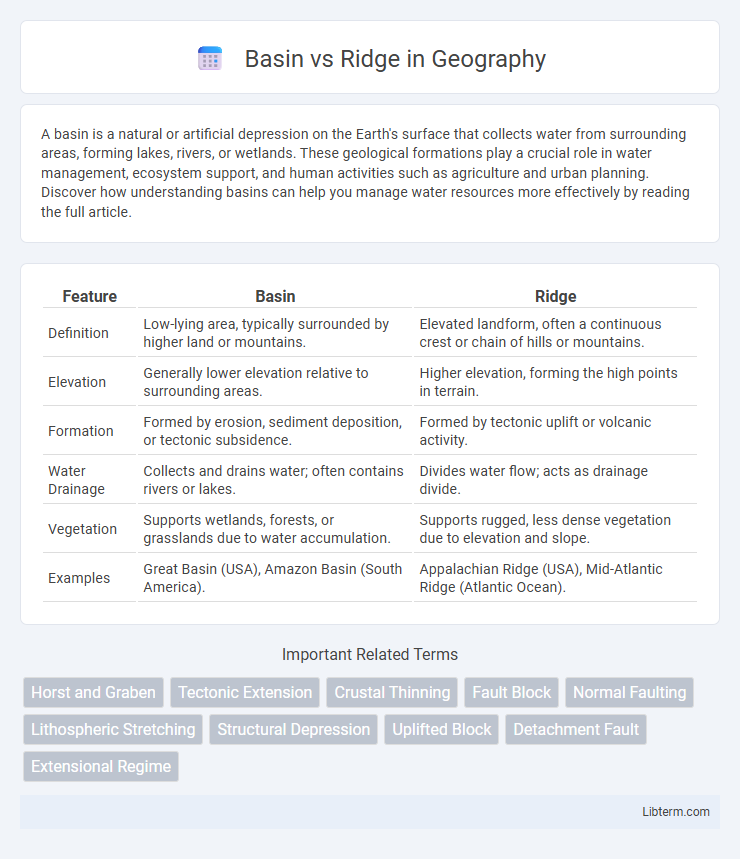A basin is a natural or artificial depression on the Earth's surface that collects water from surrounding areas, forming lakes, rivers, or wetlands. These geological formations play a crucial role in water management, ecosystem support, and human activities such as agriculture and urban planning. Discover how understanding basins can help you manage water resources more effectively by reading the full article.
Table of Comparison
| Feature | Basin | Ridge |
|---|---|---|
| Definition | Low-lying area, typically surrounded by higher land or mountains. | Elevated landform, often a continuous crest or chain of hills or mountains. |
| Elevation | Generally lower elevation relative to surrounding areas. | Higher elevation, forming the high points in terrain. |
| Formation | Formed by erosion, sediment deposition, or tectonic subsidence. | Formed by tectonic uplift or volcanic activity. |
| Water Drainage | Collects and drains water; often contains rivers or lakes. | Divides water flow; acts as drainage divide. |
| Vegetation | Supports wetlands, forests, or grasslands due to water accumulation. | Supports rugged, less dense vegetation due to elevation and slope. |
| Examples | Great Basin (USA), Amazon Basin (South America). | Appalachian Ridge (USA), Mid-Atlantic Ridge (Atlantic Ocean). |
Introduction to Basins and Ridges
Basins are low-lying geological depressions often formed by subsidence or tectonic activity, characterized by sediment accumulation that records Earth's history. Ridges are elevated linear features resulting from tectonic forces such as folding, faulting, or volcanic activity, often serving as watersheds or natural barriers. Understanding basins and ridges is essential for analyzing sedimentary processes, resource distribution, and landscape evolution in geological studies.
Defining Basins: Key Characteristics
Basins are low-lying geological depressions where sediments accumulate, often formed through tectonic subsidence or erosion. They typically feature thick sedimentary layers, gentle slopes, and serve as crucial reservoirs for groundwater and hydrocarbons. Basins influence regional drainage patterns and support diverse ecosystems due to their water retention capabilities.
Understanding Ridges: Main Features
Ridges are elongated, narrow highlands that form from tectonic plate interactions and volcanic activity, prominently found along convergent and divergent boundaries. Characterized by steep slopes and elevated crests, ridges often influence climate patterns and local ecosystems due to their altitude and orientation. The Mid-Atlantic Ridge, one of the most significant underwater ridges, exemplifies how these structures contribute to seafloor spreading and continental drift processes.
Formation Processes of Basins
Basins form primarily through subsidence caused by tectonic processes such as crustal stretching, faulting, or sediment loading, which create depressions that accumulate sediments over time. Sedimentary basins develop as a result of extensional forces pulling the crust apart or due to thermal cooling and contraction of the lithosphere. This geological subsidence contrasts with ridge formation, where uplift and volcanic activity create elevated structures.
How Ridges Are Created
Ridges are created through tectonic processes such as crustal uplift and volcanic activity, where magma rises and solidifies, building elevated landforms. They often form at convergent plate boundaries, where intense pressure causes the Earth's crust to fold and fracture, creating linear mountain ranges. Erosion and sediment deposition further shape these ridges, enhancing their distinct topographical features.
Geological Differences: Basin vs Ridge
Basins are typically large, low-lying areas formed by subsidence, where sediment accumulates over time, creating thick sedimentary deposits. Ridges are elevated, elongated landforms created by tectonic forces such as folding, faulting, or volcanic activity, resulting in exposed bedrock or uplifted strata. The main geological difference lies in their formation processes: basins act as sediment traps due to downward flexure, while ridges result from compressional forces that uplift or fold the earth's crust.
Ecological Significance of Basins and Ridges
Basins serve as crucial ecological hotspots, providing diverse habitats that support a wide variety of aquatic and terrestrial species due to their ability to collect water and nutrients. Ridges influence local microclimates and act as natural barriers that shape species distribution and migration patterns, contributing to biodiversity preservation. The interplay between basins and ridges creates unique ecological gradients important for maintaining regional ecosystem stability and resilience.
Examples of Famous Basins and Ridges
The Great Basin, spanning Nevada and parts of Utah and Oregon, is a prominent example of a large arid region characterized by a series of sediment-filled basins separated by mountain ridges. The Appalachian Mountains feature notable ridges, including the Allegheny and Blue Ridge Mountains, which display distinct linear ridges formed by folded sedimentary rock layers. In the western United States, the Basin and Range Province illustrates the classic alternating pattern of basins like the Death Valley Basin and ridges such as the Sierra Nevada.
Human Impact on Basin and Ridge Environments
Human impact on Basin and Range environments includes extensive ranching, mining, and urban development, which disrupt native ecosystems and water resources. Overgrazing by livestock leads to soil erosion and loss of native vegetation, while groundwater extraction for agriculture and cities reduces aquifer levels, threatening natural springs and wetlands. Mining activities introduce pollutants and alter landforms, exacerbating habitat fragmentation and biodiversity decline in this distinctive geologic province.
Basin vs Ridge: Comparative Analysis and Conclusion
Basin and ridge landscapes differ significantly in their geological formation and topographical characteristics, where basins are low-lying areas often filled with sediment, while ridges are elevated, narrow crest formations created by tectonic activity and erosion. Basins typically collect water and sediments, supporting diverse ecosystems and acting as natural reservoirs, whereas ridges influence weather patterns and serve as natural barriers affecting biodiversity distribution. The comparative analysis highlights that basins are crucial for agriculture and water resources, whereas ridges are essential for understanding geological processes and maintaining ecological balance in mountainous regions.
Basin Infographic

 libterm.com
libterm.com